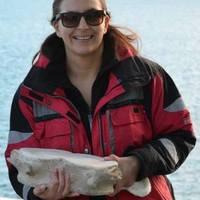- Marine Environmental History, Maritime History, History of Science and Technology, Marine Biology, Marine biodiversity, Centro de História de Além-Mar (FCSH-UNL), and 28 moreLiterature, Conservation Biology, Conservation, Cetaceans, Portugal (History), Dolphins, Whaling history, Marine Mammals Strandings, Humpback whales, History, Archaeology, Ancient History, Medieval History, Medieval Studies, Maritime Archaeology, Ancient Trade & Commerce (Archaeology), History of Science, Philosophy of Science, Monsters and Monster Theory, Atlantic World, Environmental History, Mediterranean and Black Sea Byzantine and Medieval Marine environmental history, Early Modern History, Historical Ecology, Environmental Humanities, Atlantic history, Portuguese History, and História e Cultura da Alimentaçãoedit
Research Interests:
The environmental plasticity of bottlenose dolphins leads to a range of inter-specific variations in ecological parameters that make worldwide generalizations difficult. Thus, regional studies about bottlenose dolphins are important to... more
The environmental plasticity of bottlenose dolphins leads to a range of inter-specific variations in ecological parameters that make worldwide generalizations difficult. Thus, regional studies about bottlenose dolphins are important to the overall conservation of this species. The aim of this study was to characterize for the first time bottlenose dolphins that occur in the coastal regions of Setúbal (Portugal) using two temporally distinct datasets: dataset 1 (1998–2001) and those in dataset 2 (2007–2011). Bottlenose dolphins identified in dataset 1 were considered a closed and a more cohesive group than dataset
2, with stable associations and an abundance of 106 (95% CI = 69–192) individuals. Dataset 2 seemed to be composed of an open group of 108 (95% CI = 83–177) animals, with a migration rate of 19% (SE = 0.1) individuals per year, and with low association values. The proportion of ‘regulars’ (dataset 1, 22%; dataset 2, 12%), ‘frequent’ (dataset 1, 10%; dataset 2, 14%) and ‘occasional’ (dataset 1, 68%; dataset 2, 73%) animals was relatively similar between datasets. In addition, there was no matching of individuals between datasets which could be related to large-scale movements of the individuals and/or
the carrying capacity of the study area.
2, with stable associations and an abundance of 106 (95% CI = 69–192) individuals. Dataset 2 seemed to be composed of an open group of 108 (95% CI = 83–177) animals, with a migration rate of 19% (SE = 0.1) individuals per year, and with low association values. The proportion of ‘regulars’ (dataset 1, 22%; dataset 2, 12%), ‘frequent’ (dataset 1, 10%; dataset 2, 14%) and ‘occasional’ (dataset 1, 68%; dataset 2, 73%) animals was relatively similar between datasets. In addition, there was no matching of individuals between datasets which could be related to large-scale movements of the individuals and/or
the carrying capacity of the study area.
Research Interests:
Research Interests:
Research Interests:
Research Interests:
Research Interests:
Research Interests:
Research Interests:
The purpose of this book is to address past relationship of humans and marine mammals, analyzing their common environmental, scientific and sociocultural history in the early modern Atlantic, using overlooked Portuguese sources. This book... more
The purpose of this book is to address past relationship of humans and marine mammals, analyzing their common environmental, scientific and sociocultural history in the early modern Atlantic, using overlooked Portuguese sources. This book represents a first approach to understanding how these authors and sources contributed to the development and establishment of early discourses regarding nature and the sea, monstrosities and curiosities, and to the creation of a brand new history of the exotic natural history. Many accounts of sea mammals and other large marine animals from this period offer up significant, but previously ignored, observations on marine species and environments, as well as on people’s perceptions about them and the reception and dissemination of such new and exotic knowledge. The chapters that follow will offer new and striking instances of Portuguese natural information about sea monsters that were disseminated in some early modern European channels of transmission of exotic news. I expect to show, within the context of today’s historiography, that Iberian contributions were more active and essential within early modern scientific society than we have hitherto appreciated. This information was disseminated both in traditional scientific communities but also to specific audiences at different levels of European society, outside the sphere of natural science.
